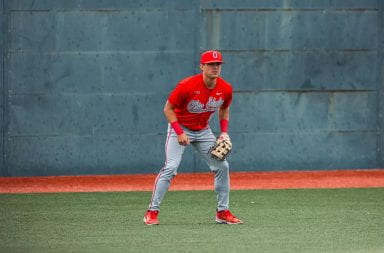As weather warms and students swarm the Oval, Frisbees, bikes and soccer balls will crowd the green space. This spring, however, one group of students will play with a different kind of soccer ball: a United Nations-blue, all-terrain “futbol.”
One World Futbol, an emerging company launched in July 2010 during the World Cup and based out of Oakland, Calif., is manufacturing what it calls the most durable soccer ball on the market. These “futbols” are made of cross-linked, closed-cell foam, similar to the material from which Crocs shoes are made. They are produced in Canada and require no hand stitching, unlike standard soccer balls.
“For every ball someone buys, we donate one to a group using sports to work with kids in harsh conditions,” said Eric Frothingham, project-managing director for One World Futbol.
Jay Nims, a fourth-year in anthropology, helped distribute soccer balls for the One World Futbol Project in Hohoe, Ghana, during Autumn Quarter.
Nims, myself and six other college students traveled to Christ Village Orphanage to volunteer for a week in September while on Semester at Sea, a University of Virginia-sponsered study abroad program. During our time at the orphanage, we taught English to a group of 8-year-old children and donated a special soccer ball from One World Futbol for the orphanage to enjoy.
“Watching the kids play with the soccer ball we brought along was a highlight of my trip. … It seemed to bring a lot of joy to the children; many of them had never played with a real soccer ball,” Nims said. “They were exhausted after two hours of continuous play.”
The energy of the Ghanian people was second to none. I am thankful for the chance to spend time with these precious children. Eventually, I plan to travel back and see the progress of the orphanage and hope to find the futbol still in play.
We are working with fellow students to promote the One World Futbol Project on Ohio State’s campus through a soccer tournament in the spring.
“The tournament would raise money to send more soccer balls to children worldwide,” Nims said.
Frothingham said One World Futbol Project’s main goal is to positively impact the lives of children around the world living in harsh conditions.
“The way we hope to do that is by supporting the work of thousands of relief and humanitarian groups around the world, using sport as a vehicle for health, development and peace by providing a unique ball that will survive the non-field conditions in which they operate,” Frothingham said.
The idea for the One World Futbol Project came about when founder Tim Jahnigen saw a video that involved Darfur refugee children kicking around a ball made of twine and decided to come up with a solution – a soccer ball that could be used in all sorts of harsh conditions and never deflate.
“Jahnigen came up with a design for the ball and was able to get funding for a prototype from the musician Sting. Then a small group came together to pursue ways of getting these balls to places where they can make a difference,” Frothingham said.
There are a lot of different ways balls are being distributed. Many involve groups who will be traveling for service projects in different countries carrying purchased or donated balls with them. One World Futbol works with groups such as Semester at Sea who bring One World Futbols for donation to service projects they visit around the world.
“Since shipping overseas can be a challenge, we seek out people willing and able to carry balls with them,” Frothingham said. “We’re starting to work with a group called ‘Roadie Relief’ that is going to get One World Futbols included in the shipping containers of equipment to support rock music tours.”
A small number of balls were taken to South Africa with a U2 tour and to South America with a Shakira tour, Frothingham said.
“We don’t claim that the ball is indestructible – as a matter of fact, with the help of an excited chimpanzee, we’ve seen that the ball can indeed be destroyed by a determined animal with strong hands and big incisors. However, we’ve run the ball over with a truck and had it return to round and playable condition,” Frothingham said. “Most importantly, we’ve gotten reports that the initial prototypes that were given to a refugee camp in Rwanda are still all in play more than a year later, where regular soccer balls tend to last no more than a week,” Frothingham said.
The One World ball sells for $39.50. The price includes the purchase of a second ball that is donated through the “Buy One, Give One” charitable model of the project.
“We’re hoping that [the ball] becomes a source of connection and commonality for people in the states and around the world – a unique ball that endures harsh conditions and treatment and symbolizes the enduring importance of play for better lives and a better world,” Frothingham said.


